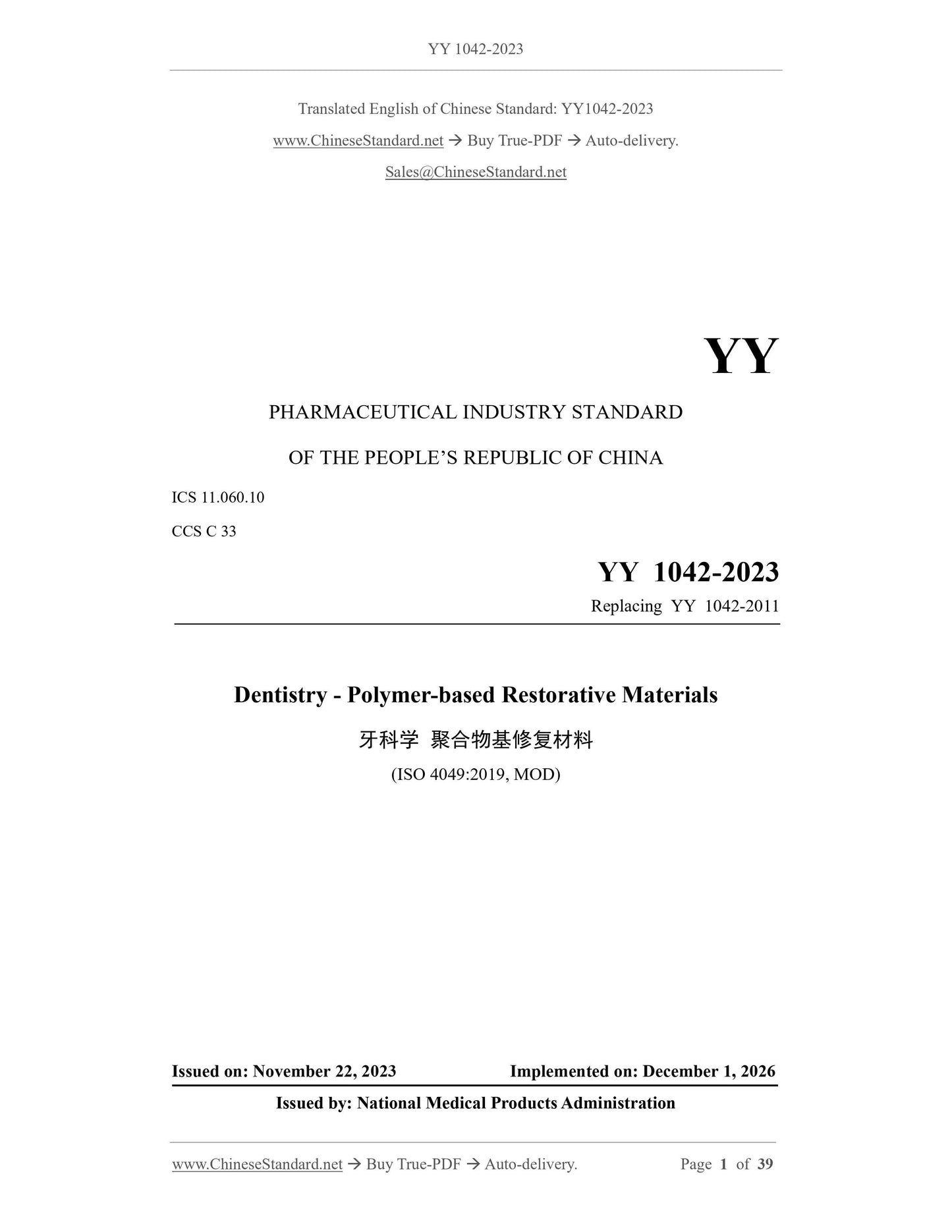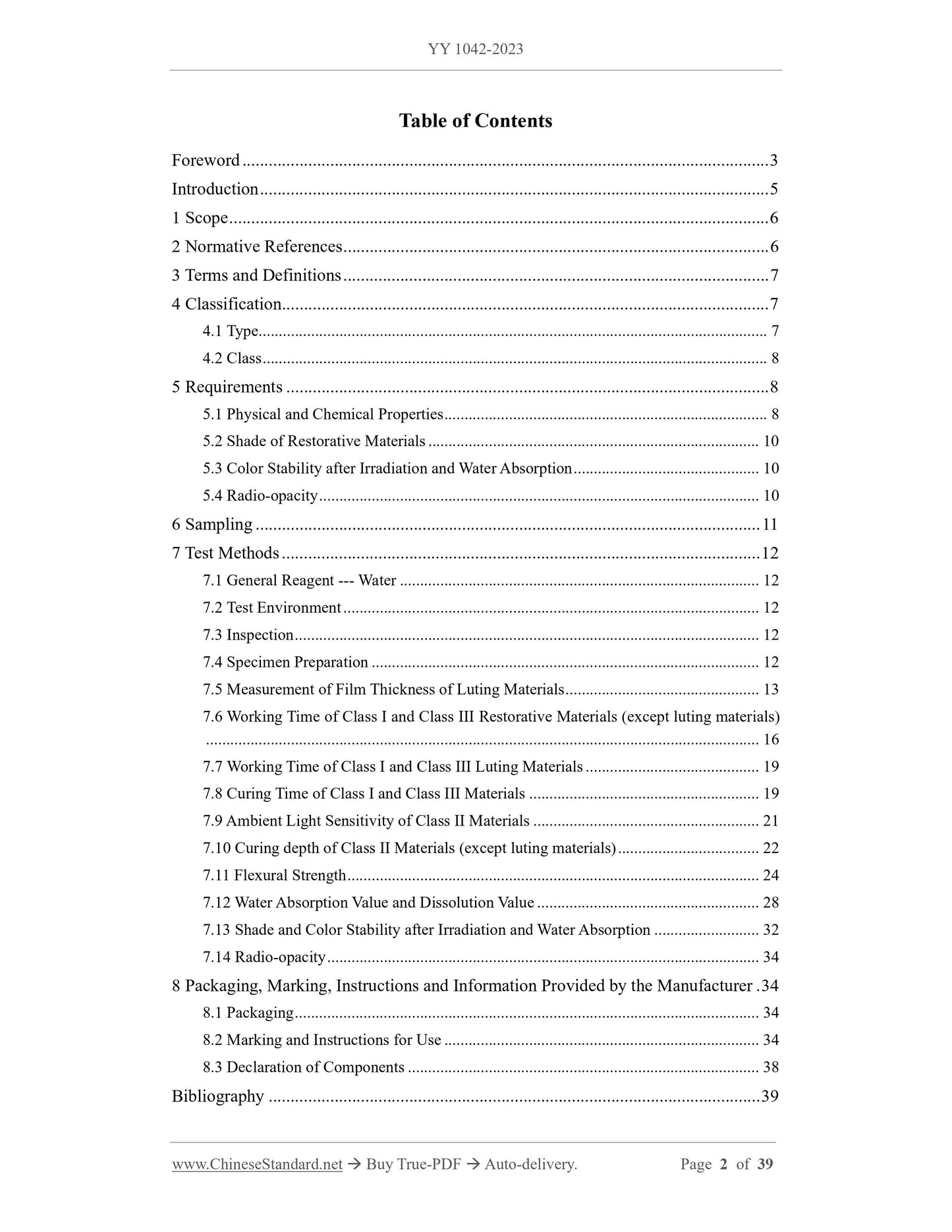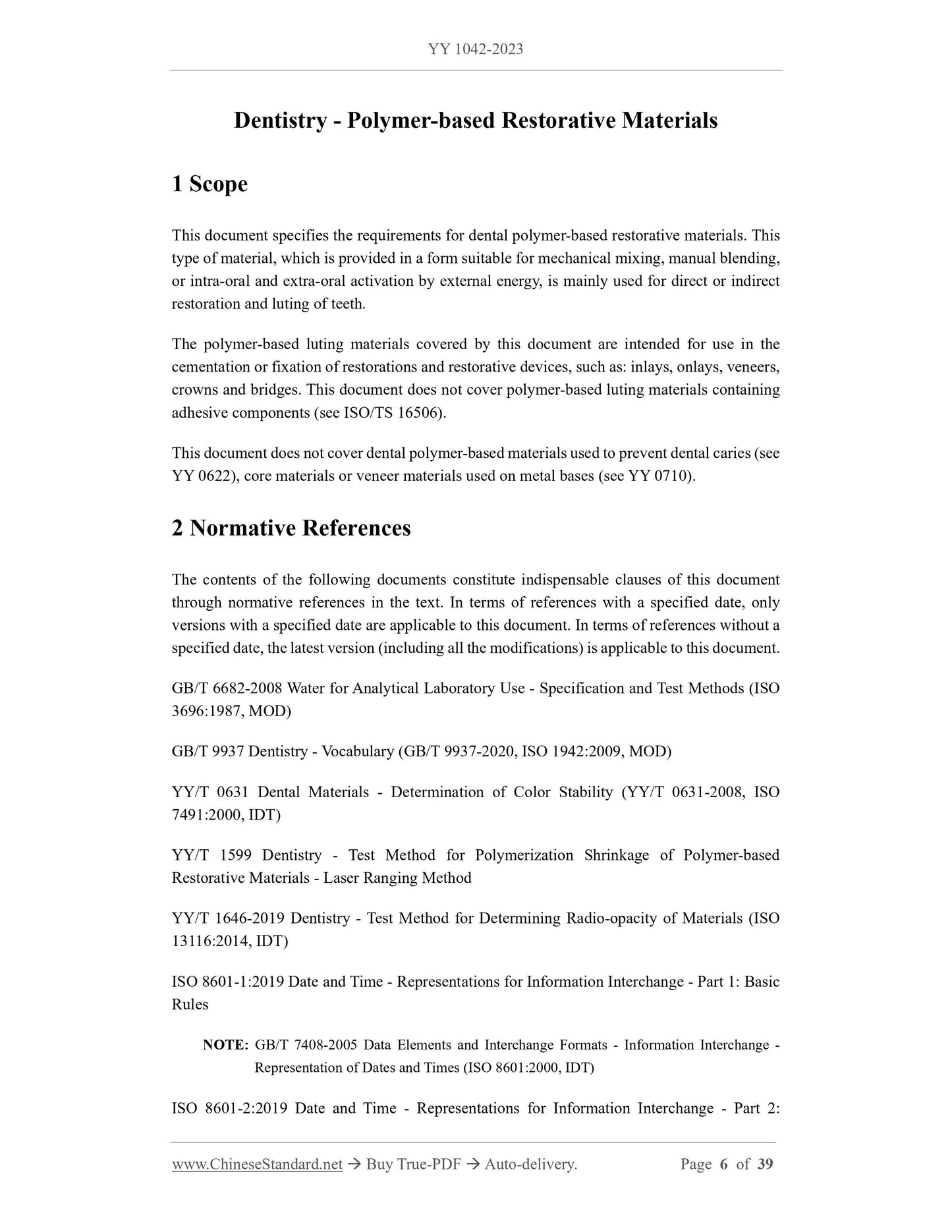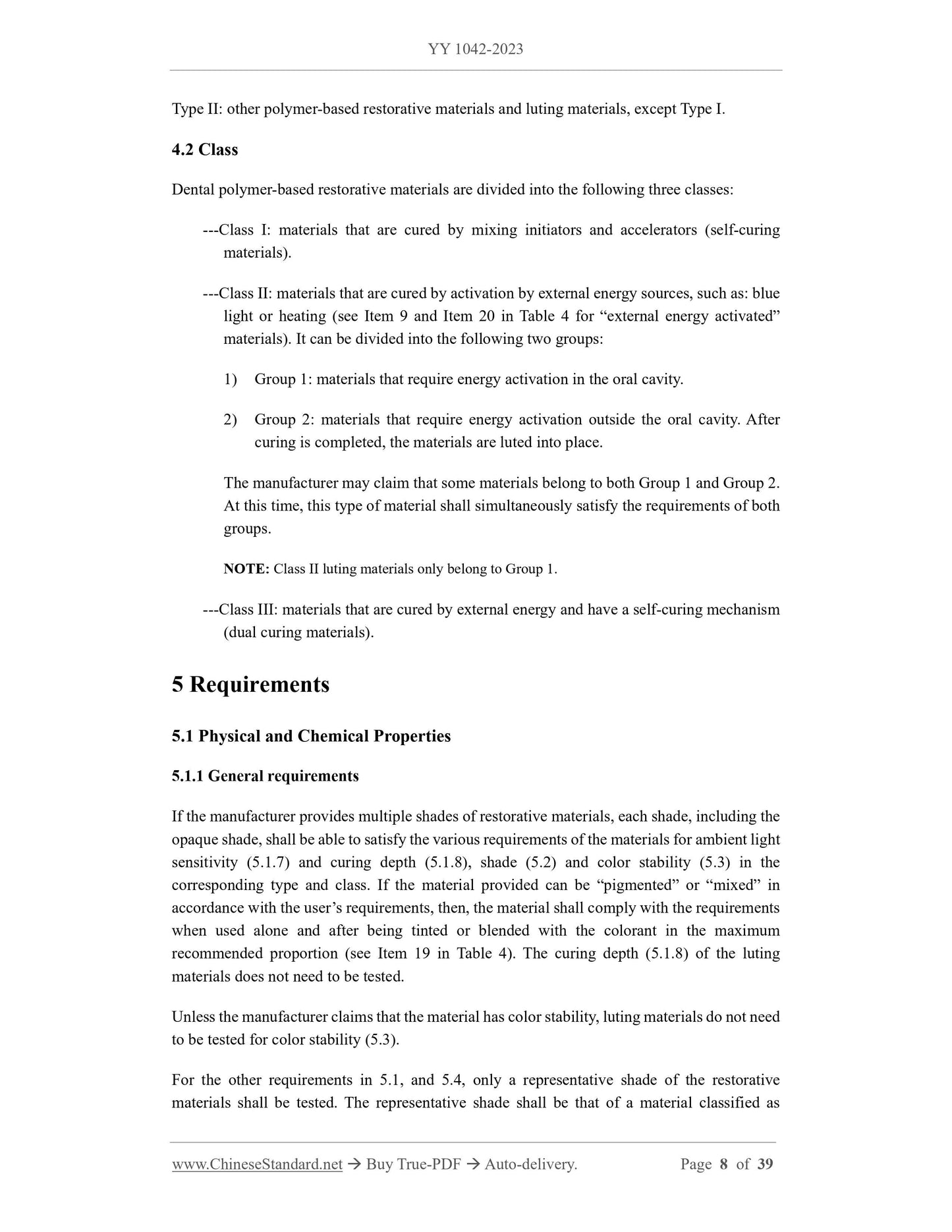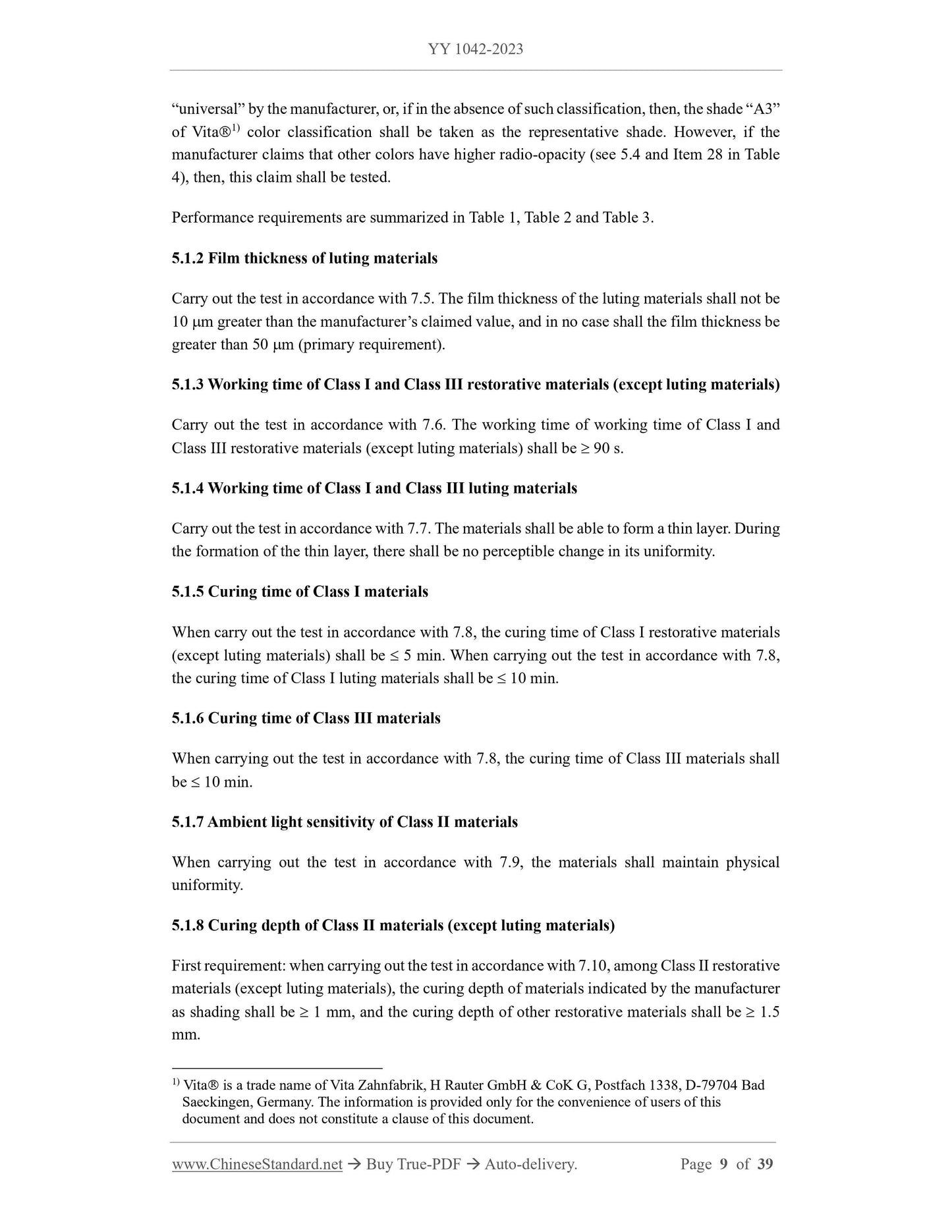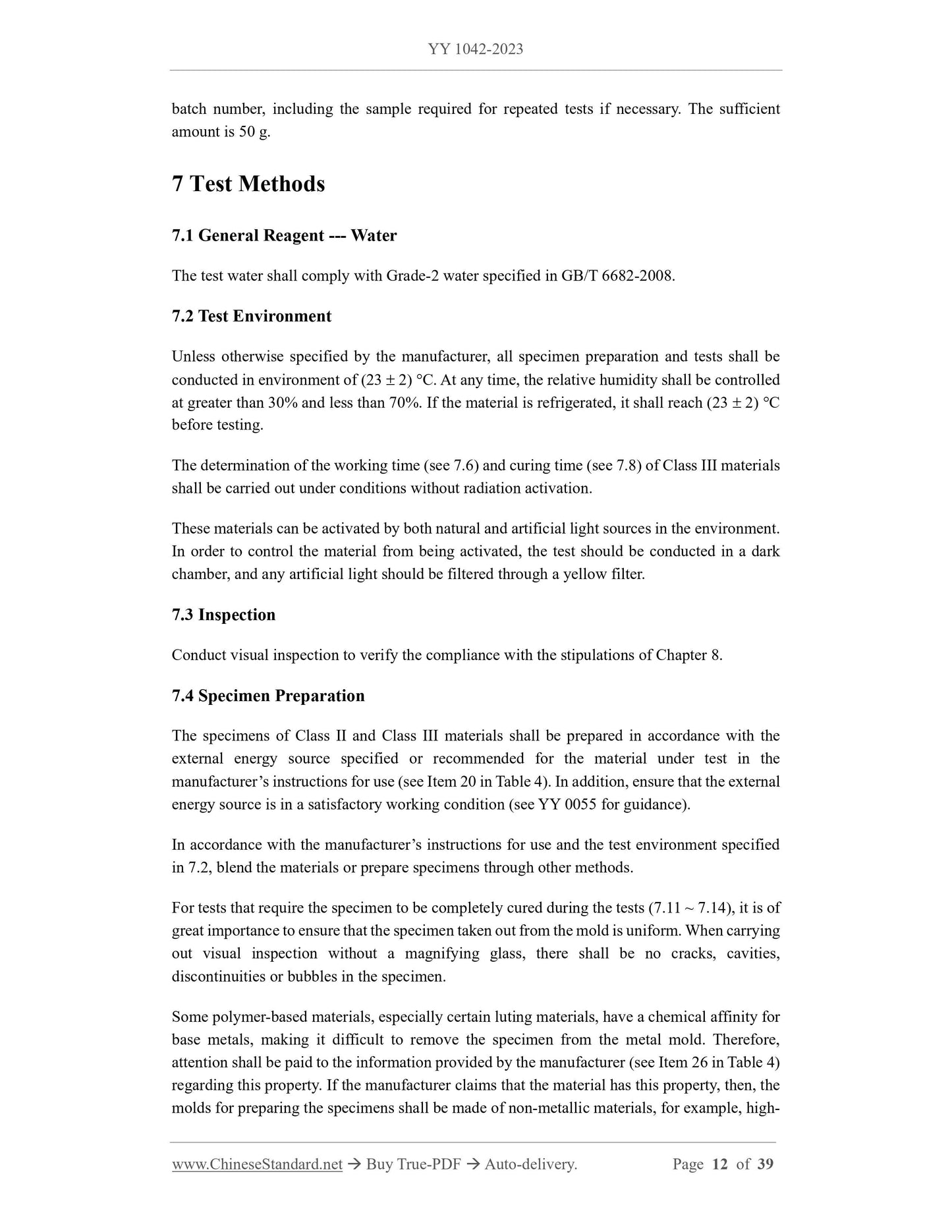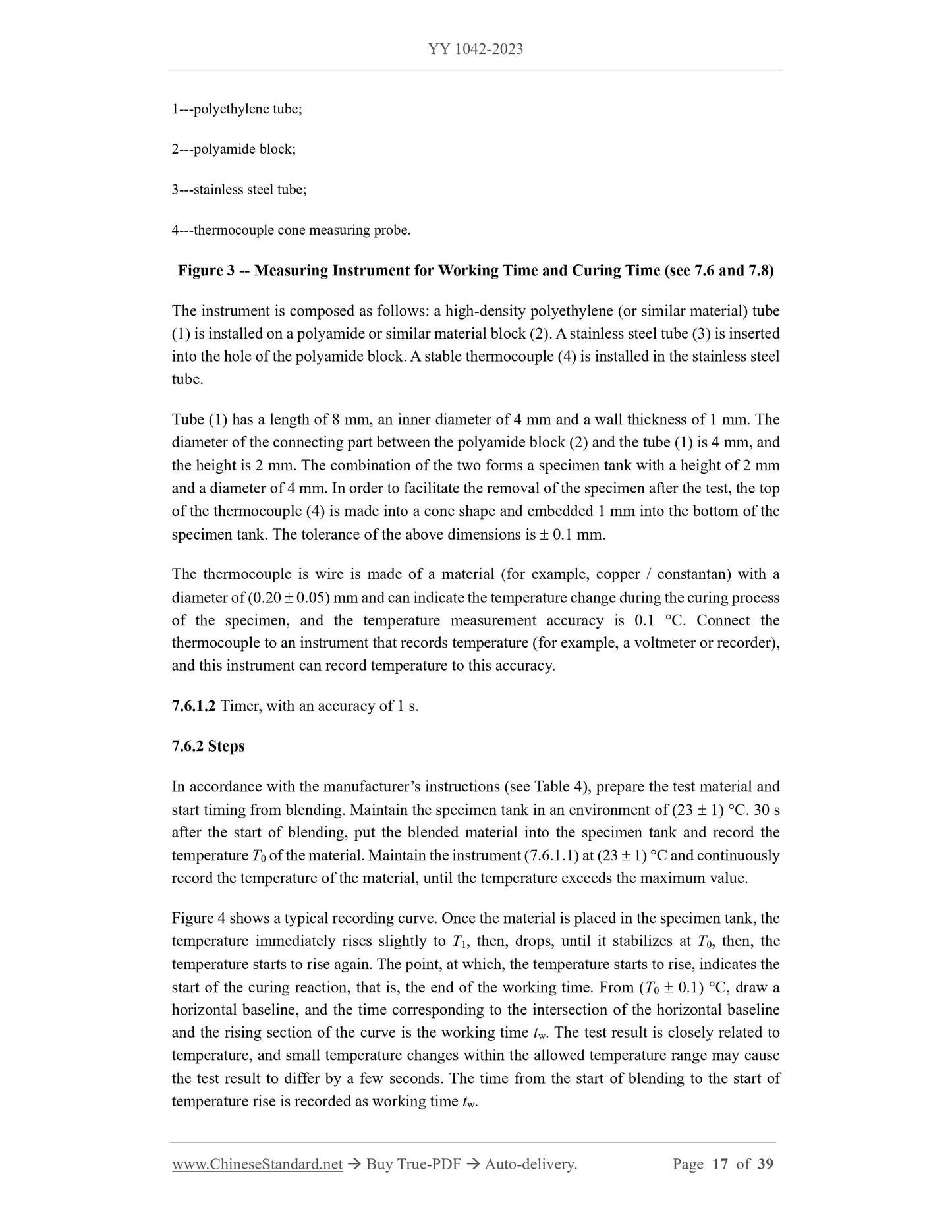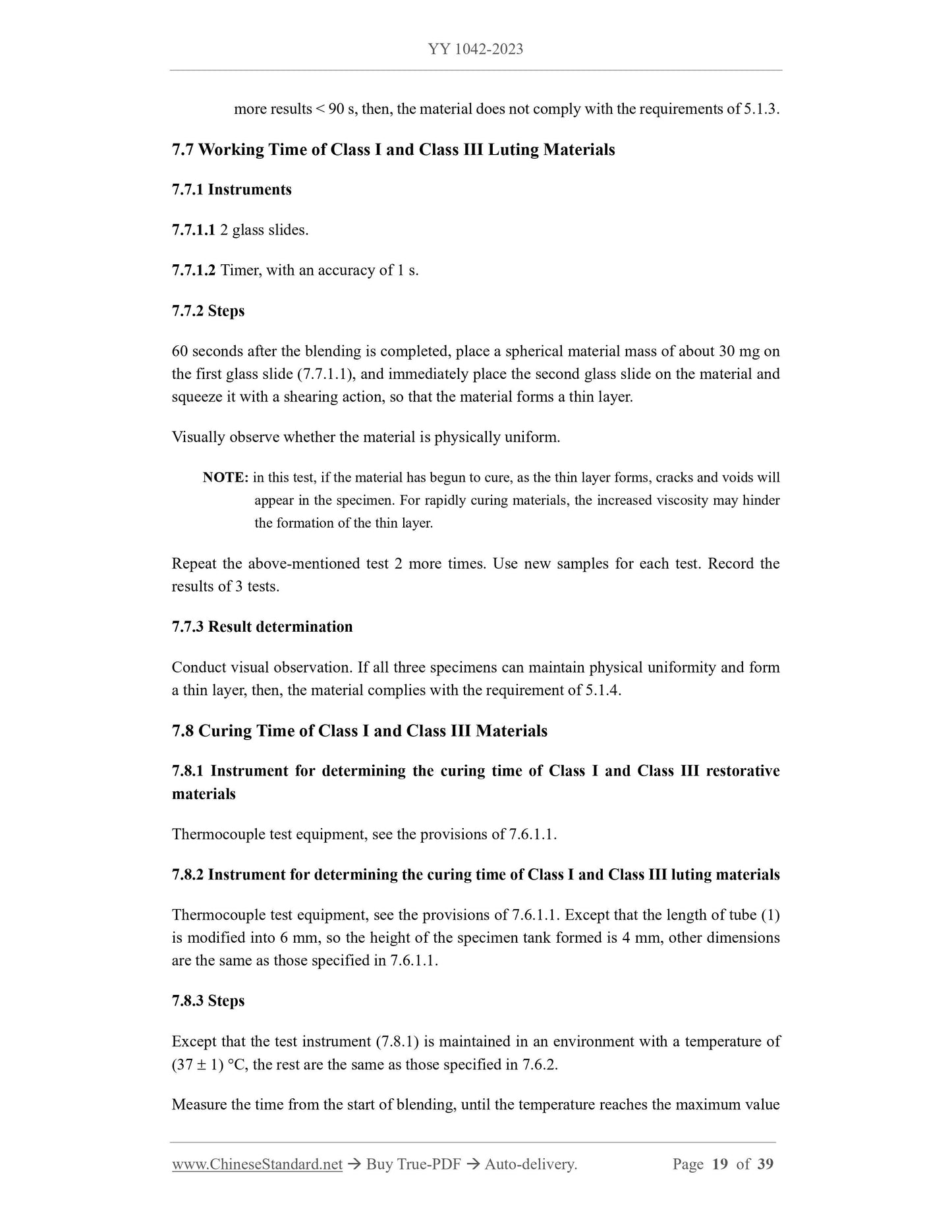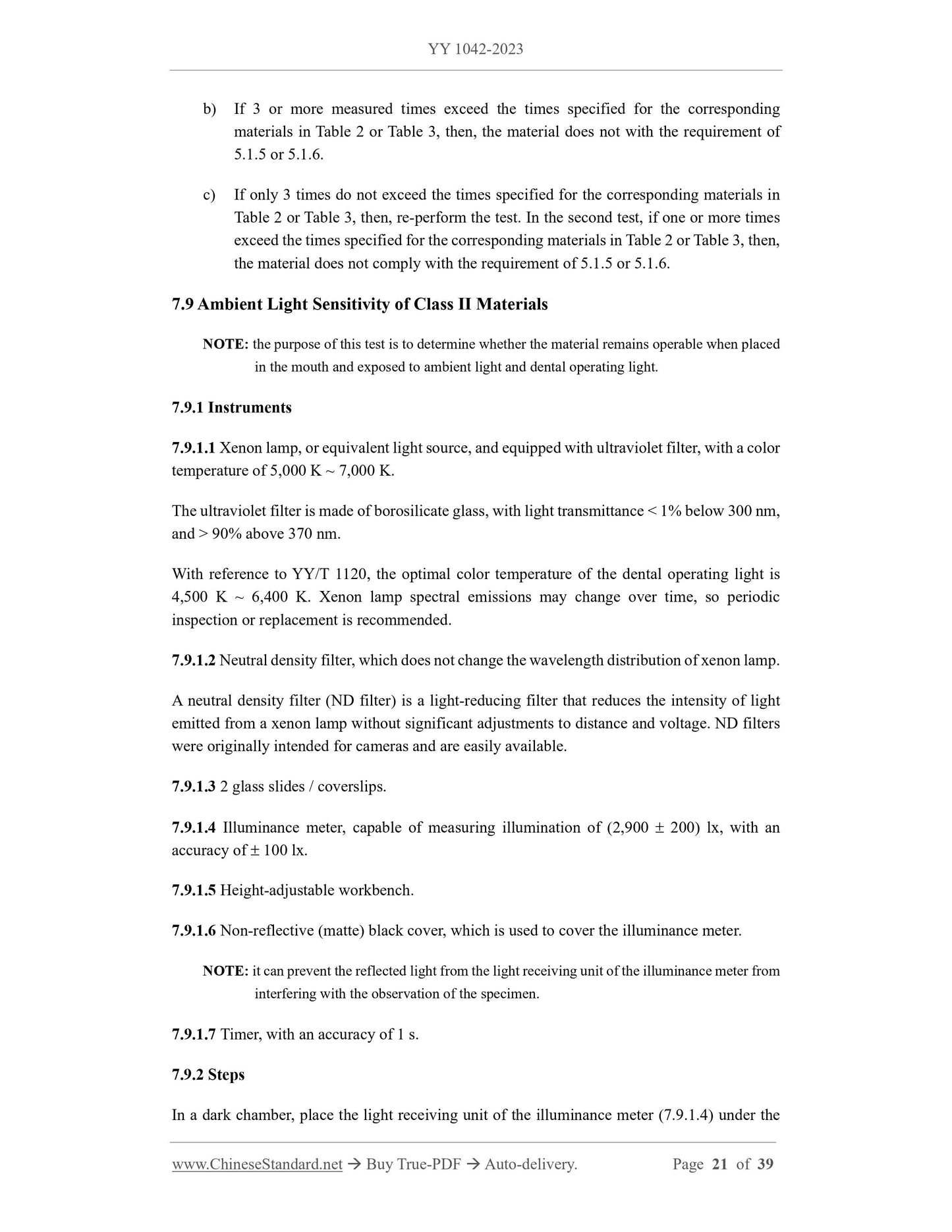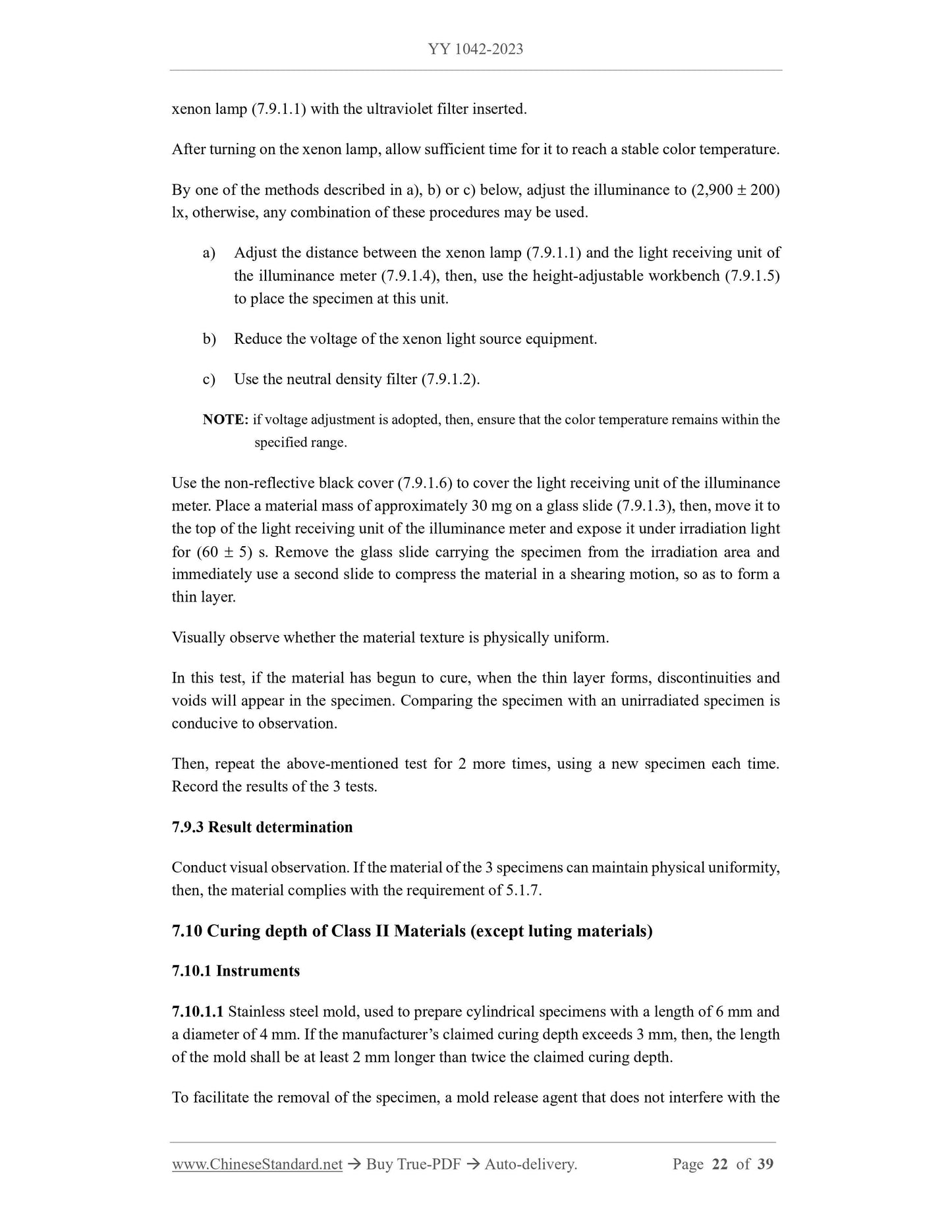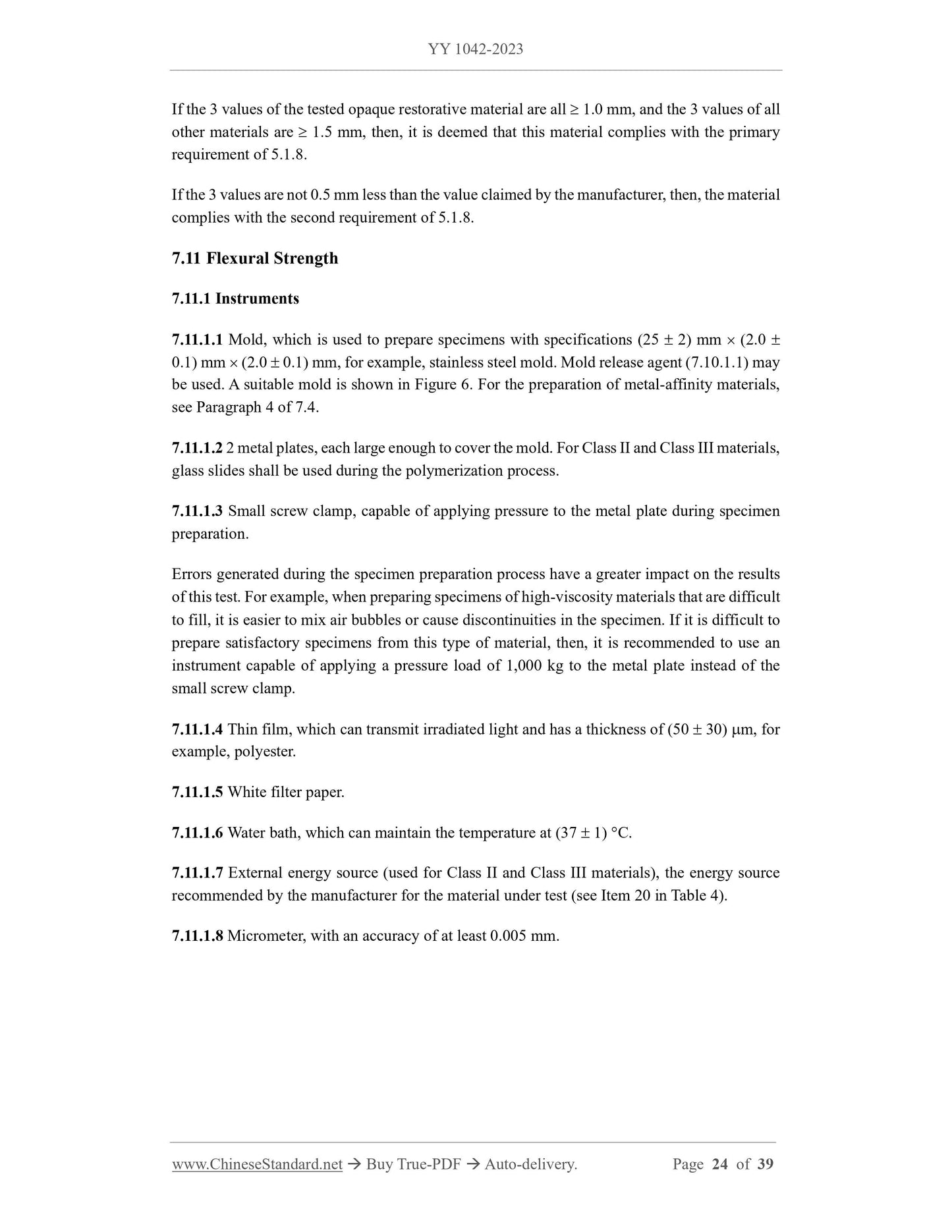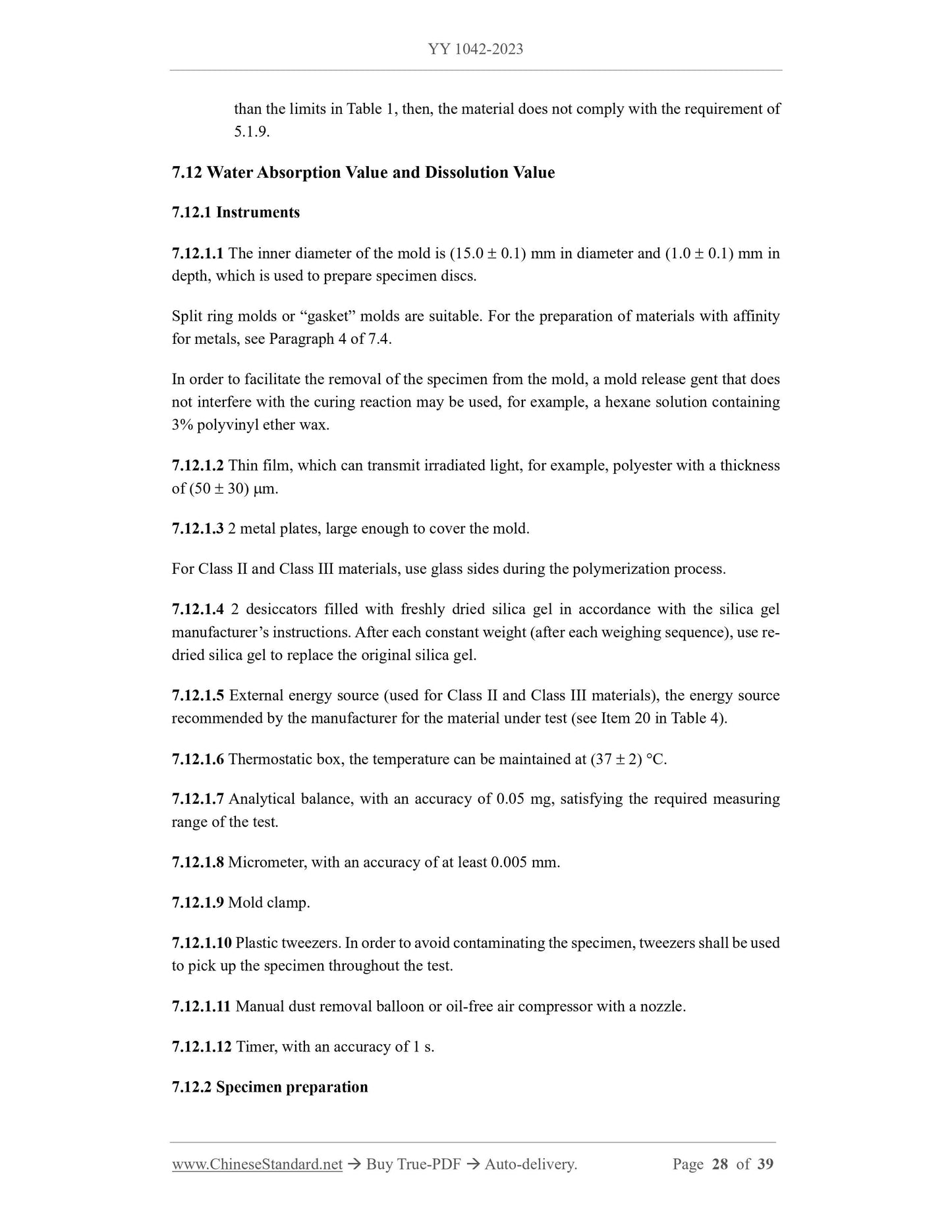1
/
の
12
PayPal, credit cards. Download editable-PDF and invoice in 1 second!
YY 1042-2023 English PDF (YY1042-2023)
YY 1042-2023 English PDF (YY1042-2023)
通常価格
$445.00 USD
通常価格
セール価格
$445.00 USD
単価
/
あたり
配送料はチェックアウト時に計算されます。
受取状況を読み込めませんでした
Delivery: 3 seconds. Download true-PDF + Invoice.
Get QUOTATION in 1-minute: Click YY 1042-2023
Historical versions: YY 1042-2023
Preview True-PDF (Reload/Scroll if blank)
YY 1042-2023: Dentistry -- Polymer-based restorative materials
YY 1042-2023
YY
PHARMACEUTICAL INDUSTRY STANDARD
ICS 11.060.10
CCS C 33
Replacing YY 1042-2011
Dentistry - Polymer-based Restorative Materials
牙科学 聚合物基修复材料
(ISO 4049.2019, MOD)
ISSUED ON. NOVEMBER 22, 2023
IMPLEMENTED ON. DECEMBER 1, 2026
Issued by. National Medical Products Administration
Table of Contents
Foreword... 3
Introduction... 5
1 Scope... 6
2 Normative References... 6
3 Terms and Definitions... 7
4 Classification... 7
4.1 Type... 7
4.2 Class... 8
5 Requirements... 8
5.1 Physical and Chemical Properties... 8
5.2 Shade of Restorative Materials... 10
5.3 Color Stability after Irradiation and Water Absorption... 10
5.4 Radio-opacity... 10
6 Sampling... 11
7 Test Methods... 12
7.1 General Reagent --- Water... 12
7.2 Test Environment... 12
7.3 Inspection... 12
7.4 Specimen Preparation... 12
7.5 Measurement of Film Thickness of Luting Materials... 13
7.6 Working Time of Class I and Class III Restorative Materials (except luting materials)
... 16
7.7 Working Time of Class I and Class III Luting Materials... 19
7.8 Curing Time of Class I and Class III Materials... 19
7.9 Ambient Light Sensitivity of Class II Materials... 21
7.10 Curing depth of Class II Materials (except luting materials)... 22
7.11 Flexural Strength... 24
7.12 Water Absorption Value and Dissolution Value... 28
7.13 Shade and Color Stability after Irradiation and Water Absorption... 32
7.14 Radio-opacity... 34
8 Packaging, Marking, Instructions and Information Provided by the Manufacturer. 34
8.1 Packaging... 34
8.2 Marking and Instructions for Use... 34
8.3 Declaration of Components... 38
Bibliography... 39
Dentistry - Polymer-based Restorative Materials
1 Scope
This document specifies the requirements for dental polymer-based restorative materials. This
type of material, which is provided in a form suitable for mechanical mixing, manual blending,
or intra-oral and extra-oral activation by external energy, is mainly used for direct or indirect
restoration and luting of teeth.
The polymer-based luting materials covered by this document are intended for use in the
cementation or fixation of restorations and restorative devices, such as. inlays, onlays, veneers,
crowns and bridges. This document does not cover polymer-based luting materials containing
adhesive components (see ISO/TS 16506).
This document does not cover dental polymer-based materials used to prevent dental caries (see
YY 0622), core materials or veneer materials used on metal bases (see YY 0710).
2 Normative References
The contents of the following documents constitute indispensable clauses of this document
through normative references in the text. In terms of references with a specified date, only
versions with a specified date are applicable to this document. In terms of references without a
specified date, the latest version (including all the modifications) is applicable to this document.
GB/T 6682-2008 Water for Analytical Laboratory Use - Specification and Test Methods (ISO
3696.1987, MOD)
GB/T 9937 Dentistry - Vocabulary (GB/T 9937-2020, ISO 1942.2009, MOD)
YY/T 0631 Dental Materials - Determination of Color Stability (YY/T 0631-2008, ISO
7491.2000, IDT)
YY/T 1599 Dentistry - Test Method for Polymerization Shrinkage of Polymer-based
Restorative Materials - Laser Ranging Method
YY/T 1646-2019 Dentistry - Test Method for Determining Radio-opacity of Materials (ISO
13116.2014, IDT)
ISO 8601-1.2019 Date and Time - Representations for Information Interchange - Part 1.Basic
Rules
NOTE. GB/T 7408-2005 Data Elements and Interchange Formats - Information Interchange -
Representation of Dates and Times (ISO 8601.2000, IDT)
ISO 8601-2.2019 Date and Time - Representations for Information Interchange - Part 2.
Type II. other polymer-based restorative materials and luting materials, except Type I.
4.2 Class
Dental polymer-based restorative materials are divided into the following three classes.
---Class I. materials that are cured by mixing initiators and accelerators (self-curing
materials).
---Class II. materials that are cured by activation by external energy sources, such as. blue
light or heating (see Item 9 and Item 20 in Table 4 for “external energy activated”
materials). It can be divided into the following two groups.
1) Group 1.materials that require energy activation in the oral cavity.
2) Group 2.materials that require energy activation outside the oral cavity. After
curing is completed, the materials are luted into place.
The manufacturer may claim that some materials belong to both Group 1 and Group 2.
At this time, this type of material shall simultaneously satisfy the requirements of both
groups.
NOTE. Class II luting materials only belong to Group 1.
---Class III. materials that are cured by external energy and have a self-curing mechanism
(dual curing materials).
5 Requirements
5.1 Physical and Chemical Properties
5.1.1 General requirements
If the manufacturer provides multiple shades of restorative materials, each shade, including the
opaque shade, shall be able to satisfy the various requirements of the materials for ambient light
sensitivity (5.1.7) and curing depth (5.1.8), shade (5.2) and color stability (5.3) in the
corresponding type and class. If the material provided can be “pigmented” or “mixed” in
accordance with the user’s requirements, then, the material shall comply with the requirements
when used alone and after being tinted or blended with the colorant in the maximum
recommended proportion (see Item 19 in Table 4). The curing depth (5.1.8) of the luting
materials does not need to be tested.
Unless the manufacturer claims that the material has color stability, luting materials do not need
to be tested for color stability (5.3).
For the other requirements in 5.1, and 5.4, only a representative shade of the restorative
materials shall be tested. The representative shade shall be that of a material classified as
“universal” by the manufacturer, or, if in the absence of such classification, then, the shade “A3”
of Vita1) color classification shall be taken as the representative shade. However, if the
manufacturer claims that other colors have higher radio-opacity (see 5.4 and Item 28 in Table
4), then, this claim shall be tested.
Performance requirements are summarized in Table 1, Table 2 and Table 3.
5.1.2 Film thickness of luting materials
Carry out the test in accordance with 7.5.The film thickness of the luting materials shall not be
10 m greater than the manufacturer’s claimed value, and in no case shall the film thickness be
greater than 50 m (primary requirement).
5.1.3 Working time of Class I and Class III restorative materials (except luting materials)
Carry out the test in accordance with 7.6.The working time of working time of Class I and
Class III restorative materials (except luting materials) shall be 90 s.
5.1.4 Working time of Class I and Class III luting materials
Carry out the test in accordance with 7.7.The materials shall be able to form a thin layer. During
the formation of the thin layer, there shall be no perceptible change in its uniformity.
5.1.5 Curing time of Class I materials
When carry out the test in accordance with 7.8, the curing time of Class I restorative materials
(except luting materials) shall be 5 mi...
Get QUOTATION in 1-minute: Click YY 1042-2023
Historical versions: YY 1042-2023
Preview True-PDF (Reload/Scroll if blank)
YY 1042-2023: Dentistry -- Polymer-based restorative materials
YY 1042-2023
YY
PHARMACEUTICAL INDUSTRY STANDARD
ICS 11.060.10
CCS C 33
Replacing YY 1042-2011
Dentistry - Polymer-based Restorative Materials
牙科学 聚合物基修复材料
(ISO 4049.2019, MOD)
ISSUED ON. NOVEMBER 22, 2023
IMPLEMENTED ON. DECEMBER 1, 2026
Issued by. National Medical Products Administration
Table of Contents
Foreword... 3
Introduction... 5
1 Scope... 6
2 Normative References... 6
3 Terms and Definitions... 7
4 Classification... 7
4.1 Type... 7
4.2 Class... 8
5 Requirements... 8
5.1 Physical and Chemical Properties... 8
5.2 Shade of Restorative Materials... 10
5.3 Color Stability after Irradiation and Water Absorption... 10
5.4 Radio-opacity... 10
6 Sampling... 11
7 Test Methods... 12
7.1 General Reagent --- Water... 12
7.2 Test Environment... 12
7.3 Inspection... 12
7.4 Specimen Preparation... 12
7.5 Measurement of Film Thickness of Luting Materials... 13
7.6 Working Time of Class I and Class III Restorative Materials (except luting materials)
... 16
7.7 Working Time of Class I and Class III Luting Materials... 19
7.8 Curing Time of Class I and Class III Materials... 19
7.9 Ambient Light Sensitivity of Class II Materials... 21
7.10 Curing depth of Class II Materials (except luting materials)... 22
7.11 Flexural Strength... 24
7.12 Water Absorption Value and Dissolution Value... 28
7.13 Shade and Color Stability after Irradiation and Water Absorption... 32
7.14 Radio-opacity... 34
8 Packaging, Marking, Instructions and Information Provided by the Manufacturer. 34
8.1 Packaging... 34
8.2 Marking and Instructions for Use... 34
8.3 Declaration of Components... 38
Bibliography... 39
Dentistry - Polymer-based Restorative Materials
1 Scope
This document specifies the requirements for dental polymer-based restorative materials. This
type of material, which is provided in a form suitable for mechanical mixing, manual blending,
or intra-oral and extra-oral activation by external energy, is mainly used for direct or indirect
restoration and luting of teeth.
The polymer-based luting materials covered by this document are intended for use in the
cementation or fixation of restorations and restorative devices, such as. inlays, onlays, veneers,
crowns and bridges. This document does not cover polymer-based luting materials containing
adhesive components (see ISO/TS 16506).
This document does not cover dental polymer-based materials used to prevent dental caries (see
YY 0622), core materials or veneer materials used on metal bases (see YY 0710).
2 Normative References
The contents of the following documents constitute indispensable clauses of this document
through normative references in the text. In terms of references with a specified date, only
versions with a specified date are applicable to this document. In terms of references without a
specified date, the latest version (including all the modifications) is applicable to this document.
GB/T 6682-2008 Water for Analytical Laboratory Use - Specification and Test Methods (ISO
3696.1987, MOD)
GB/T 9937 Dentistry - Vocabulary (GB/T 9937-2020, ISO 1942.2009, MOD)
YY/T 0631 Dental Materials - Determination of Color Stability (YY/T 0631-2008, ISO
7491.2000, IDT)
YY/T 1599 Dentistry - Test Method for Polymerization Shrinkage of Polymer-based
Restorative Materials - Laser Ranging Method
YY/T 1646-2019 Dentistry - Test Method for Determining Radio-opacity of Materials (ISO
13116.2014, IDT)
ISO 8601-1.2019 Date and Time - Representations for Information Interchange - Part 1.Basic
Rules
NOTE. GB/T 7408-2005 Data Elements and Interchange Formats - Information Interchange -
Representation of Dates and Times (ISO 8601.2000, IDT)
ISO 8601-2.2019 Date and Time - Representations for Information Interchange - Part 2.
Type II. other polymer-based restorative materials and luting materials, except Type I.
4.2 Class
Dental polymer-based restorative materials are divided into the following three classes.
---Class I. materials that are cured by mixing initiators and accelerators (self-curing
materials).
---Class II. materials that are cured by activation by external energy sources, such as. blue
light or heating (see Item 9 and Item 20 in Table 4 for “external energy activated”
materials). It can be divided into the following two groups.
1) Group 1.materials that require energy activation in the oral cavity.
2) Group 2.materials that require energy activation outside the oral cavity. After
curing is completed, the materials are luted into place.
The manufacturer may claim that some materials belong to both Group 1 and Group 2.
At this time, this type of material shall simultaneously satisfy the requirements of both
groups.
NOTE. Class II luting materials only belong to Group 1.
---Class III. materials that are cured by external energy and have a self-curing mechanism
(dual curing materials).
5 Requirements
5.1 Physical and Chemical Properties
5.1.1 General requirements
If the manufacturer provides multiple shades of restorative materials, each shade, including the
opaque shade, shall be able to satisfy the various requirements of the materials for ambient light
sensitivity (5.1.7) and curing depth (5.1.8), shade (5.2) and color stability (5.3) in the
corresponding type and class. If the material provided can be “pigmented” or “mixed” in
accordance with the user’s requirements, then, the material shall comply with the requirements
when used alone and after being tinted or blended with the colorant in the maximum
recommended proportion (see Item 19 in Table 4). The curing depth (5.1.8) of the luting
materials does not need to be tested.
Unless the manufacturer claims that the material has color stability, luting materials do not need
to be tested for color stability (5.3).
For the other requirements in 5.1, and 5.4, only a representative shade of the restorative
materials shall be tested. The representative shade shall be that of a material classified as
“universal” by the manufacturer, or, if in the absence of such classification, then, the shade “A3”
of Vita1) color classification shall be taken as the representative shade. However, if the
manufacturer claims that other colors have higher radio-opacity (see 5.4 and Item 28 in Table
4), then, this claim shall be tested.
Performance requirements are summarized in Table 1, Table 2 and Table 3.
5.1.2 Film thickness of luting materials
Carry out the test in accordance with 7.5.The film thickness of the luting materials shall not be
10 m greater than the manufacturer’s claimed value, and in no case shall the film thickness be
greater than 50 m (primary requirement).
5.1.3 Working time of Class I and Class III restorative materials (except luting materials)
Carry out the test in accordance with 7.6.The working time of working time of Class I and
Class III restorative materials (except luting materials) shall be 90 s.
5.1.4 Working time of Class I and Class III luting materials
Carry out the test in accordance with 7.7.The materials shall be able to form a thin layer. During
the formation of the thin layer, there shall be no perceptible change in its uniformity.
5.1.5 Curing time of Class I materials
When carry out the test in accordance with 7.8, the curing time of Class I restorative materials
(except luting materials) shall be 5 mi...
Share
